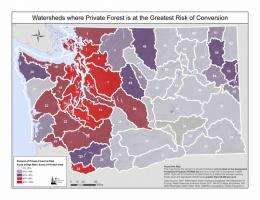State may have brief window to slow loss of working forests to development

(PhysOrg.com) -- Today's slumping economy and housing market may reduce, temporarily, the insistent economic forces on Washington's private forestland owners to give up the cycle of harvesting and replanting trees in favor of converting the land to other uses, such as lots for houses.
This is the breathing-room-chance for the Washington Legislature to take steps to stop the loss of working forests and halt forest fragmentation, says Brian Boyle, who leads the University of Washington's Northwest Environmental Forum, which focuses on these issues.
Recommendations from forum participants and new research by the UW College of Forest Resources are combined in a report "Retention of High-Valued Forest Lands at Risk of Conversion to Non-forest Uses in Washington State," just delivered to the Legislature.
Population pressures, changing forest ownership and the desire for rural housing sites are fragmenting once-contiguous private forests into patches that are economically unfeasible and environmentally undesirable, the report says.
The report says steps to improve the social, economical and biological productivity of forestlands will be futile unless the issues of parcelization and fragmentation are addressed head on, Boyle says. Forests, even those harvested periodically, provide far more protection for streams, wildlife habitat and carbon storage than when the forest is converted.
During the last five years the forum has brought together more than 400 participants from 94 organizations, representing environmental advocacy groups, land trust organizations, tribal nations, the forest industry, non-industrial forest owners, academia and government to developed a coherent understanding of the forest conversion issue and broad agreement on needed actions.
"The alternative is to stand by and watch the continuing deterioration of our working forest land base," Boyle says. The report examines mechanisms such as paying landowners for conservation easements, using public funds to purchase working forests and buying development rights for a set period or even in perpetuity. Forum participants said the highest priority should be the creation of a legislatively-appointed task force to propose regulatory and policy clarification and an integrated set of taxes and incentives.
The report provides new survey data on what landowners say they would accept in annual per-acre payments to not develop or subdivide their properties -- as low as $10 per acre, depending on the time horizon.
For the report, UW researchers have for the first time produced estimates of private and tribal forestlands at risk of conversion. The data reveal, for example, that nearly 28 percent of King County private forestlands are at risk for conversion. For Snohomish County, the number is just over 46 percent, and in Pierce County, a little more than 27 percent. Lands considered at risk for conversion are places where property assessments of the land alone are higher than the value of the land for growing trees. Such valuations often entice owners to quit the forestry business and turn their land to other uses that can make them more money, says Boyle, who served 12 years as the state commissioner of public lands.
The most threatened forestlands in Western Washington are in Island County, with 83 percent at risk, and San Juan County, at 71 percent. That's because the land value for residences or vacation homes is particularly high on islands, according to Luke Rogers, UW College of Forest Resources lead research scientist on the project.
The counties in Western Washington with the least risk for conversion are Grays Harbor, with only about 5 percent at risk, and Pacific County, only about 2 percent. This is because coastal areas of the state face less housing pressure and have some of the best ground for growing trees profitably, Rogers says.
Rogers and other UW researchers developed the Washington State Forest Database and used it to calculate the potential risk of conversion. The database contains information -- including property valuations, forest soil productivity, forest cover, tax status -- about more than 3 million governmental, tribal and private forest properties.
One advantage of the new database is that it gives the best accounting ever of non-industrial forestlands. These lands range from family-owned timberlands to large private tracts to tribal nation-owned lands. Of the 11.6 million acres of private forestlands, about half are considered non-industrial. There are about 55,000 non-industrial properties in the state larger than 20 acres.
Non-industrial forestland owners own many of the forests left in lowland areas between developed areas and large public or industrial forestlands, the database shows. And these owners have their own pressures that could lead to conversion, according to Gordon Bradley, UW professor of forest resources and principal investigator on the report. For instance, rules about buffers that must be left around streams during logging are quite complex and, in the case of small parcels ribboned with numerous streams, the rules may keep the landowner from logging at all, which often results in the sale of the land.
The 2007 Legislature allocated $200,000 for the Washington Department of Natural Resources to contract with the UW's College of Forest Resources to address this issue, and Northwest Environmental Forum participants have recommended specific actions.
Boyle, quoting from the report, says, "The end-state question is: Can Washington make the necessary policy and financial commitments to ensure that forest values compare favorably with alternative land uses?"
More information: The report and cover letter to the Legislature are at: www.nwenvironmentalforum.org/ .
Provided by University of Washington (news : web)














